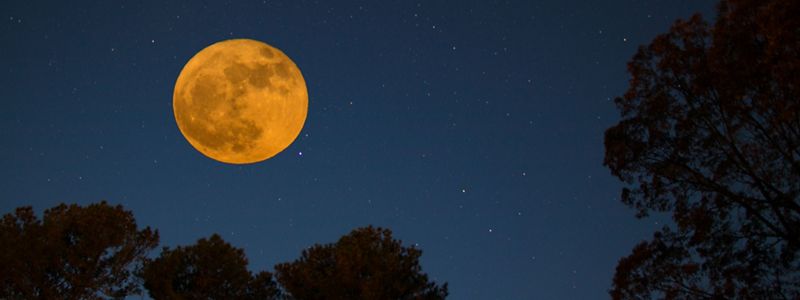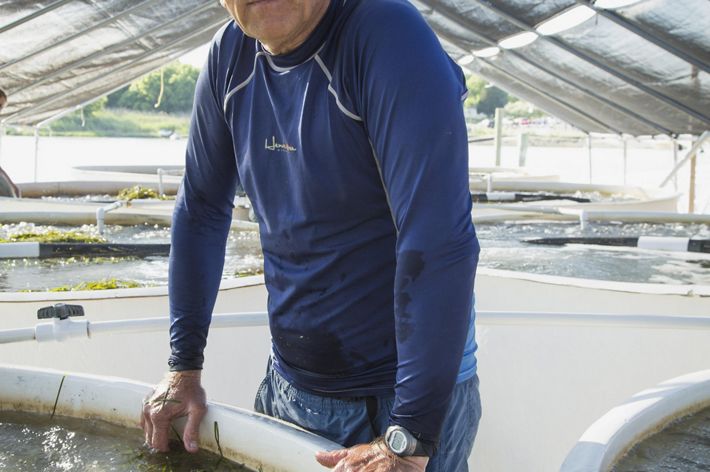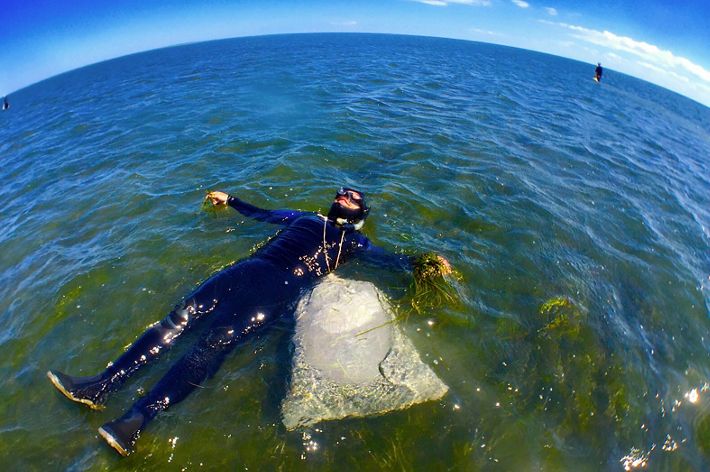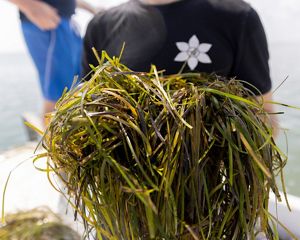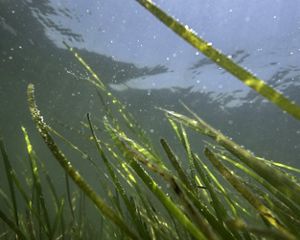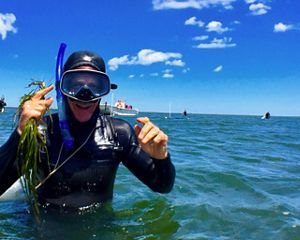Restoring Eelgrass on Virginia’s Eastern Shore
Go into the water and behind the scenes of the largest successful seagrass restoration project in the world.

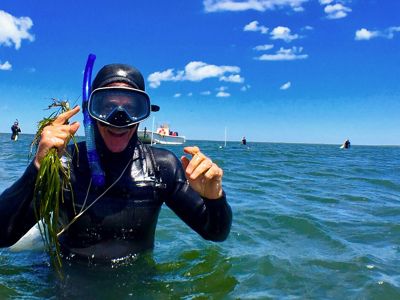
In the early 1930s, a noxious slime mold and the powerful Chesapeake-Potomac Hurricane combined to devastate seagrass meadows in Virginia’s coastal bays. While seagrasses did regenerate in the Chesapeake, they never returned to Virginia's other coastal bays.
A patch of eelgrass was discovered in 1999 in a seaside bay off the Eastern Shore. It may have taken root from seeds that had drifted down from Chincoteague Bay. According to Dr. Robert “JJ” Orth from the Virginia Institute of Marine Science (VIMS), “That’s when the light went on that conditions there might be ripe for recovery, as long as there was a source of seeds.”
Each spring since 2008, 40 to 60 volunteers have signed on and suited up to collect eelgrass (Zostera marina), a simple seagrass that once thrived in the coastal bays of Virginia, but was virtually wiped out in the 1930s by disease and hurricane. While volunteer collection was curtailed for two years due to Covid, 2022 saw more volunteers than in recent memory turn out! 79 volunteers filled 10 tanks with seeds, giving 287 hours over 7 days. Over more than a decade nearly 500 volunteers have given 2,175 hours to the effort.
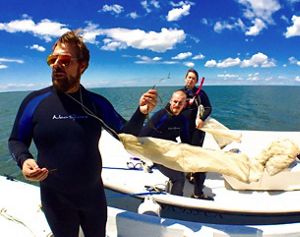
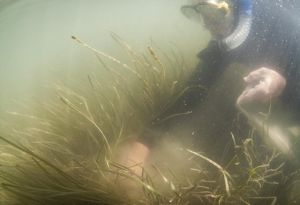
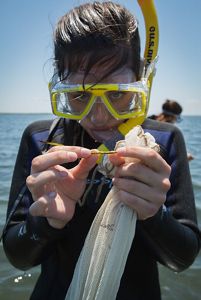
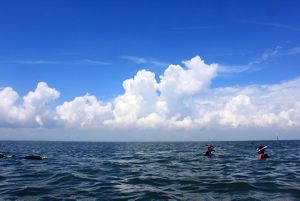
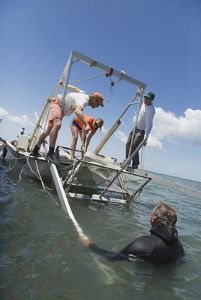
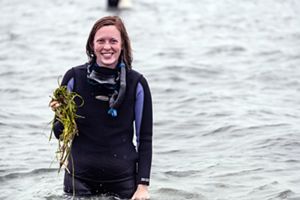
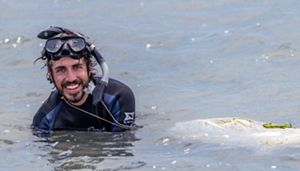
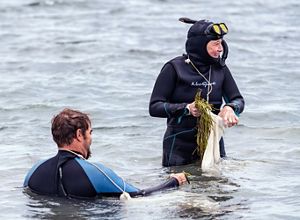
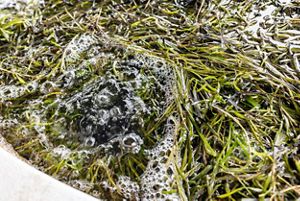
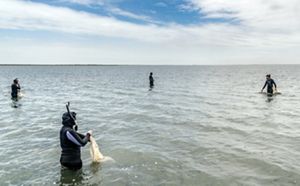

Restoration Success: Coastal Scientist Bo Lusk holds up an eelgrass shoot while explaining the seed collection process to volunteers. The sack tied around his neck will be used for collection. © Alex Novak / TNC

Collecting Eelgrass: A volunteer gathers shoots containing ripe seeds. The shoots are measured into water tanks where the seeds are cured, separated and prepared for planting in the fall. © Mark Godfrey / TNC

One Seed at a Time: A volunteer stands in the shallow water of South Bay holding an eelgrass shoot. The annual collection event is a part of one of the largest recovery efforts in the world. © Peter Frank Edwards

Restoration Success: Volunteer snorkelers collect seagrass shoots in a shallow coastal bay. © Daniel White / TNC

Working with Partners: Staff and volunteers from VIMS collect eelgrass trimmings with a boat-mounted mower. The process is similar to mowing a lawn; the eelgrass will soon grow back. © Peter Frank Edwards

Virginia's Volunteers : 2022 saw more volunteers than in recent memory turn out! Over more than a decade nearly 500 volunteers have given 2,175 hours to the eelgrass collection effort. © Mark Schwenk

Seagrass Smiles: Volunteers sported wetsuits and smiles--even on a day when water temps were 62 degrees! © Mark Schwenk

Staff and Volunteers: Coastal Scientist Bo Lusk (left) in the water with a volunteer during eelgrass collection, May 2022. © Mark Schwenk

Curing Tanks: Eelgrass shoots are measured into holding tanks to cure. The seeds will be extracted and stored in sea water until fall, when they will be sown back into the seaside bays. © Mark Schwenk

Volunteers in Action: 79 volunteers joined TNC over 10 days of collection in the shallow coastal bays of Virginia's Eastern Shore. May 2022. © Mark Schwenk
Quote: Bo Lusk
The Eastern Shore community has provided a willing partner to this restoration. Working side-by-side with hundreds of volunteers collecting seeds for this project is a highlight of each spring.
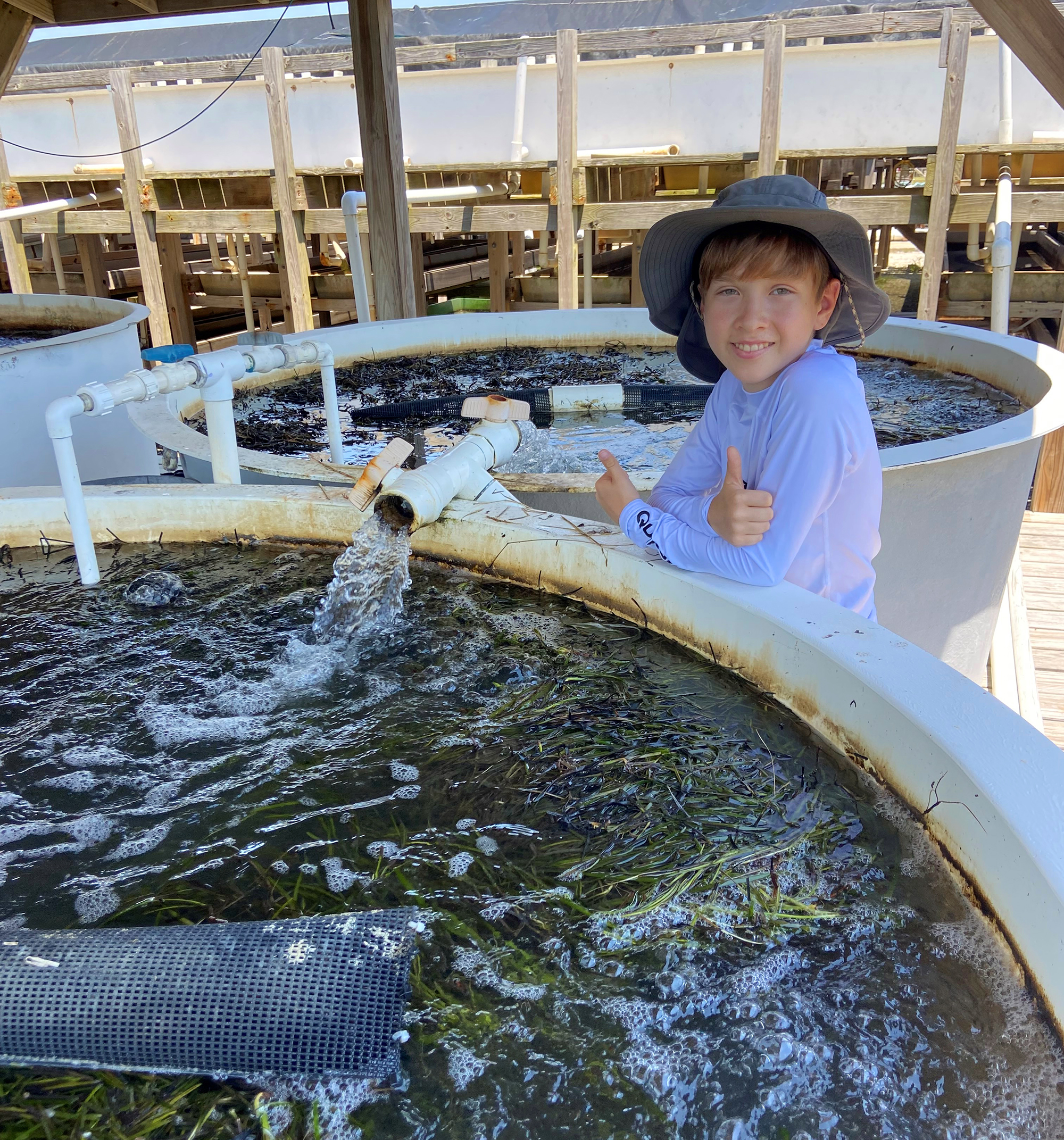
Volunteer Spotlight
My Snorkeling Adventure
11-year-old Kai shares his experience as an eelgrass volunteer.
We drove an hour and a half north up to the Eastern Shore to a remote area. Once we got there we suited up in wetsuits and got on one of two boats. On the way out there, we got a class on eelgrass and the history of the estuary.
The water was above my knees, almost to my waist. Nice shallow waters with many creatures to be found. It was very calm. Floating through the shallow water above the eelgrass was such a peaceful and calm place with all kinds of sea life. I found knobbed whelks, silverside fish and small mud crabs, four live whelks and a few hermit crabs.
I also found a toadfish hiding inside a whelk shell and a bunch of scallops—did you know that if you take a scallop out of the water for a bit, it slowly opens its mouth and then snaps shut! I also learned the little blue dots around the rim of their shell are actually eyes and that they can push themselves through the water with their ductor muscle.
It’s a simple task to pick out the seeds from the flat grass, but I did get majorly distracted by the sea life!
This experience was awesome. It was like swimming through an abyss of underwater grasses with sea life everywhere you look. Sometimes you find yourself so focused that you forget about the outside world or even what you are supposed to be doing. Time flew by very fast even though this journey was only a few hours long.
The group collected a total of 25 bags of eelgrass seeds, which were dumped into big tanks where they combined them with collections from previous days. I learned that the seeds will pop out of the shoots and the grasses will decompose.
As it decomposes, the oxygen gets used up, but the seeds do better with oxygen, so they stir the tanks every day. By early July the seeds are all popped out, so they skim the leftover grasses off the top, and the seeds drop to the bottom. They will move the seeds to smaller tanks, where they control the temperature so they don’t sprout yet. In October they will throw the seeds out in the areas that need more eelgrasses and then check back in March and hope it grew!
Everyone can do something every day to help the environment. It can be as easy as picking up trash and not littering. But if you can volunteer, it is a good way to meet people while having fun, learning something new and making a difference. This was a really awesome experience, and if you go, I hope you will enjoy it too!
Ripe for Recovery
After they're collected, the eelgrass shoots are measured into holding tanks to cure. The seeds will be extracted and stored in sea water until fall, when they will be sown back into the seaside bays.
Starting from the mere remnant discovered in a seaside bay, TNC and VIMS have since broadcast more than 72 million seeds into 600 acres to help accelerate the natural spread of eelgrass, which now covers 9,000 acres in South, Spider Crab, Hog Island and Cobb Island bays.
VVCR’s eelgrass restoration is also the subject of a blue carbon feasibility study, the first of its kind in world, which provides the potential for future implementation of a long-term carbon credit project.
If you have questions or concerns regarding our blue carbon seagrass project, please contact Jill Bieri, Volgenau Virginia Coast Reserve Program Director, by phone at 757-442-5416 or email jbieri@tnc.org.
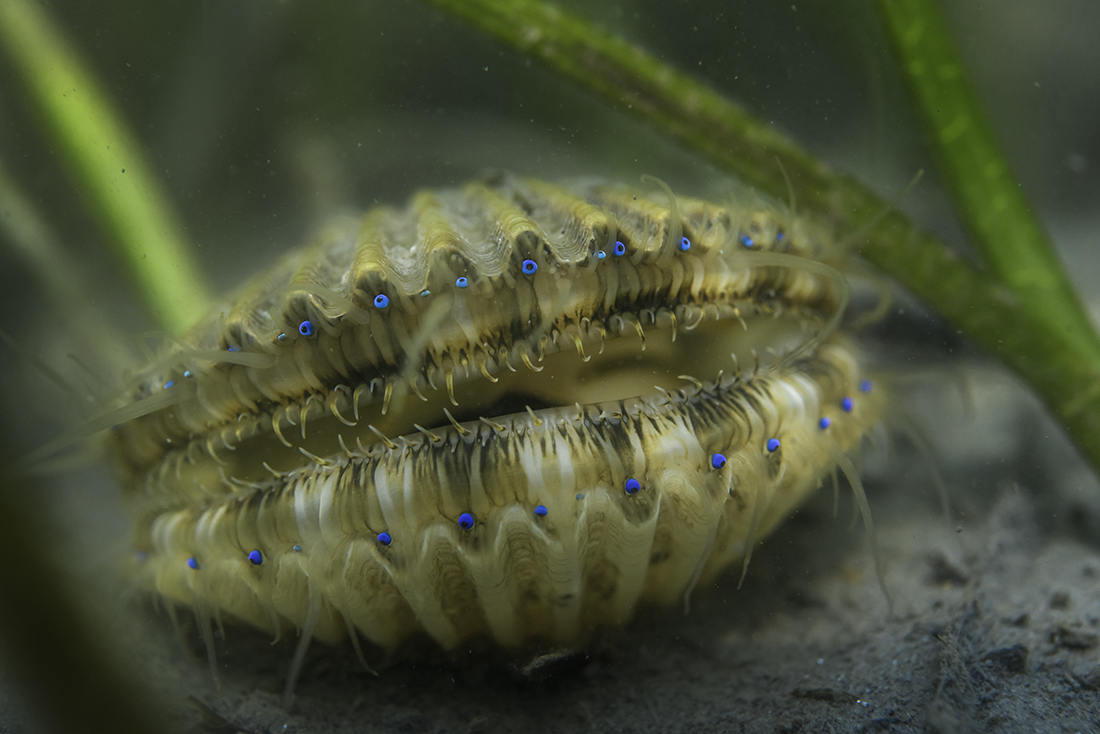
Turning the Tide
Bringing Scallops Back to Coastal Bays
As eelgrass collapsed, it created a ripple effect. Virginia supported the most productive bay scallop fishery in the United States in 1930; with the loss of this critical nursery habitat, commercially important bay scallops completely disappeared from Virginia’s waters.
But after more than 80 years, the tide may be turning.
TNC is working with VIMS on an effort to produce and grow scallops from larvae to juvenile size. In May 2017, we released 12.3 million bay scallop larvae that were spawned by VIMS and Cherrystone Aquafarms into the eelgrass in South Bay.
Scallops affix themselves to blades of seagrass which provide shelter from strong currents and from predators like crabs and rays. Along with our partners at VIMS, we’re working to build on our successful eelgrass restoration efforts in the hope of eventually restoring a self-sustaining population of bay scallops to Virginia waters.
Stay In Touch
Sign up to receive monthly conservation news and updates from Virginia. Get a preview of Virginia's Nature News email
